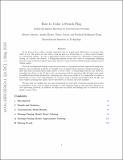| dc.contributor.author | Ancona, B | |
| dc.contributor.author | Bajwa, A | |
| dc.contributor.author | Lynch, N | |
| dc.contributor.author | Mallmann-Trenn, F | |
| dc.date.accessioned | 2021-11-05T18:43:11Z | |
| dc.date.available | 2021-11-05T18:43:11Z | |
| dc.date.issued | 2020 | |
| dc.identifier.uri | https://hdl.handle.net/1721.1/137574 | |
| dc.description.abstract | © 2020, Springer Nature Switzerland AG. In the French flag problem, initially uncolored cells on a grid must differentiate to become blue, white or red. The goal is for the cells to color the grid as a French flag, i.e., a three-colored triband, in a distributed manner. To solve a generalized version of the problem in a distributed computational setting, we consider two models: a biologically-inspired version that relies on morphogens (diffusing proteins acting as chemical signals) and a more abstract version based on reliable message passing between cellular agents. Much of developmental biology research focuses on concentration-based approaches, since morphogen gradients are an underlying mechanism in tissue patterning. We show that both model types easily achieve a French ribbon - a French flag in the 1D case. However, extending the ribbon to the 2D flag in the concentration model is somewhat difficult unless each agent has additional positional information. Assuming that cells are identical, it is impossible to achieve a French flag or even a close approximation. In contrast, using a message-based approach in the 2D case only requires assuming that agents can be represented as logarithmic or constant size state machines. We hope that our insights may lay some groundwork for what kind of message passing abstractions or guarantees, if any, may be useful in analogy to cells communicating at long and short distances to solve patterning problems. We also hope our models and findings may be of interest in the design of nano-robots. | en_US |
| dc.language.iso | en | |
| dc.publisher | Springer International Publishing | en_US |
| dc.relation.isversionof | 10.1007/978-3-030-61792-9_33 | en_US |
| dc.rights | Creative Commons Attribution-Noncommercial-Share Alike | en_US |
| dc.rights.uri | http://creativecommons.org/licenses/by-nc-sa/4.0/ | en_US |
| dc.source | arXiv | en_US |
| dc.title | How to Color a French Flag: Biologically Inspired Algorithms for Scale-Invariant Patterning | en_US |
| dc.type | Article | en_US |
| dc.identifier.citation | Ancona, B, Bajwa, A, Lynch, N and Mallmann-Trenn, F. 2020. "How to Color a French Flag: Biologically Inspired Algorithms for Scale-Invariant Patterning." Lecture Notes in Computer Science (including subseries Lecture Notes in Artificial Intelligence and Lecture Notes in Bioinformatics), 12118 LNCS. | |
| dc.contributor.department | Massachusetts Institute of Technology. Department of Electrical Engineering and Computer Science | |
| dc.contributor.department | Massachusetts Institute of Technology. Computer Science and Artificial Intelligence Laboratory | |
| dc.relation.journal | Lecture Notes in Computer Science (including subseries Lecture Notes in Artificial Intelligence and Lecture Notes in Bioinformatics) | en_US |
| dc.eprint.version | Original manuscript | en_US |
| dc.type.uri | http://purl.org/eprint/type/ConferencePaper | en_US |
| eprint.status | http://purl.org/eprint/status/NonPeerReviewed | en_US |
| dc.date.updated | 2021-01-29T14:39:45Z | |
| dspace.orderedauthors | Ancona, B; Bajwa, A; Lynch, N; Mallmann-Trenn, F | en_US |
| dspace.date.submission | 2021-01-29T14:39:49Z | |
| mit.journal.volume | 12118 LNCS | en_US |
| mit.license | OPEN_ACCESS_POLICY | |
| mit.metadata.status | Authority Work and Publication Information Needed | en_US |
